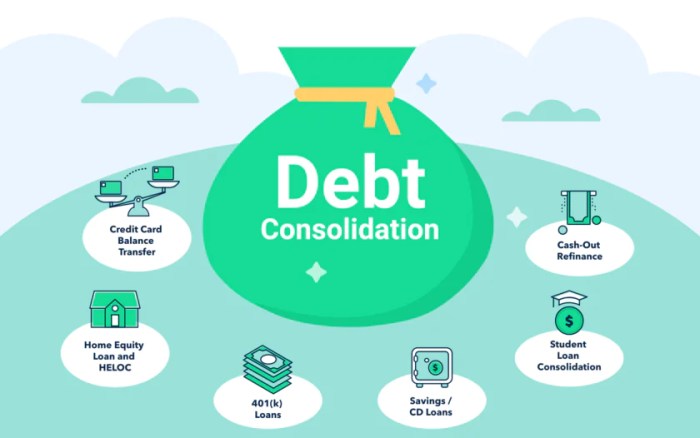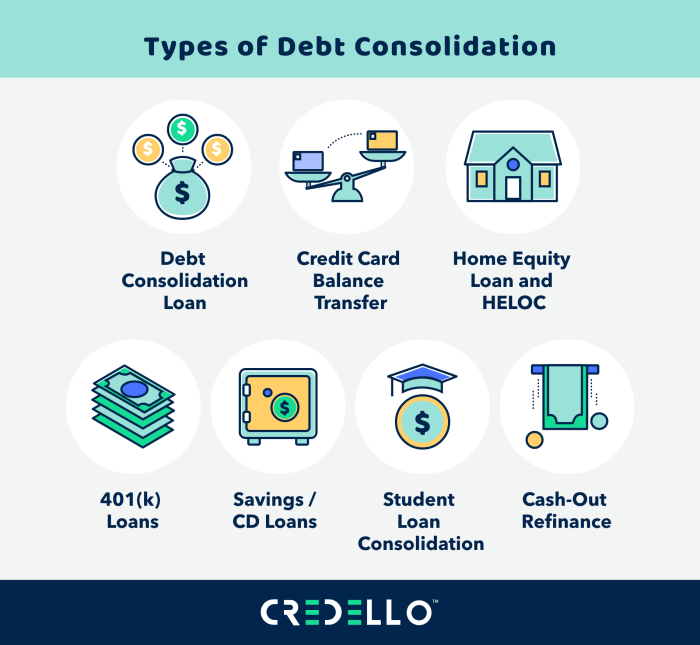
Navigating the complexities of student loan repayment can feel overwhelming, especially when juggling multiple loans with varying interest rates and repayment schedules. Loan consolidation offers a potential solution, simplifying the process and potentially reducing monthly payments. This comprehensive guide explores the intricacies of student loan consolidation, empowering you to make informed decisions about your financial future.
We will delve into the various types of consolidation programs available, outlining the benefits and drawbacks of each. We’ll examine eligibility criteria, interest rates, repayment plans, and potential risks, providing a clear understanding of how consolidation can impact your overall financial picture. Ultimately, our goal is to equip you with the knowledge necessary to confidently navigate the world of student loan consolidation and make the best choice for your unique circumstances.
Interest Rates and Repayment Plans
Understanding interest rates and repayment plans is crucial for effectively managing your consolidated student loans. The right strategy can significantly impact your long-term financial health, potentially saving you thousands of dollars. This section details how these factors work together to determine your overall loan cost.
Interest Rate Determination for Consolidated Loans
The interest rate on a consolidated student loan is a weighted average of the interest rates on your existing federal student loans. This means the rate isn’t simply the average of your individual loan rates; instead, it’s calculated based on the proportion of each loan’s principal balance to the total principal balance. For example, a larger loan will have a proportionally greater influence on the final consolidated interest rate. The interest rate is fixed for the life of the loan, meaning it won’t change, unlike some variable-rate loans. It’s important to note that private student loans are typically not included in federal consolidation programs.
Repayment Plan Options After Consolidation
Several repayment plans are available after consolidating federal student loans. Choosing the right plan depends on your financial situation and long-term goals. The most common options include:
Standard Repayment Plan: This plan typically involves fixed monthly payments over a 10-year period. It’s the shortest repayment period and results in the lowest total interest paid.
Extended Repayment Plan: This plan stretches payments over a longer period (up to 25 years), resulting in lower monthly payments but higher total interest paid over the life of the loan.
Graduated Repayment Plan: Payments start low and gradually increase over time, often reflecting anticipated income growth. This can be helpful in the early stages of a career but leads to higher total interest payments compared to the standard plan.
Income-Driven Repayment (IDR) Plans: These plans (such as ICR, PAYE, REPAYE, and IBR) base monthly payments on your income and family size. Payments are typically lower, but the repayment period can extend beyond 20 or 25 years. Remaining balances may be forgiven after a certain period, but this forgiveness is considered taxable income.
Long-Term Cost Savings (or Increased Costs)
The long-term cost of your consolidated loans significantly depends on the repayment plan you choose. A shorter repayment period like the Standard Repayment Plan will result in lower total interest paid but higher monthly payments. Conversely, longer repayment periods such as the Extended Repayment Plan or IDR plans will have lower monthly payments but result in significantly higher total interest paid over the life of the loan. It’s crucial to carefully weigh the trade-offs between lower monthly payments and higher overall costs.
Examples of Calculating Monthly Payments
Let’s consider two scenarios:
Scenario 1: $30,000 loan at 5% interest over 10 years (Standard Repayment Plan). Using a loan amortization calculator (readily available online), the estimated monthly payment would be approximately $311. The total interest paid over 10 years would be around $13,320.
Scenario 2: $30,000 loan at 5% interest over 25 years (Extended Repayment Plan). The estimated monthly payment would be approximately $166. However, the total interest paid would be significantly higher, around $39,000.
Impact of Interest Rates and Repayment Plans on Total Repaid
The following table illustrates the impact of different interest rates and repayment plans on the total amount repaid for a $30,000 loan. These are estimates and actual amounts may vary slightly based on the specific loan terms and amortization schedule.
| Interest Rate | Repayment Plan | Approximate Monthly Payment | Approximate Total Interest Paid | Approximate Total Repaid |
|---|---|---|---|---|
| 5% | Standard (10 years) | $311 | $13,320 | $43,320 |
| 5% | Extended (25 years) | $166 | $39,000 | $69,000 |
| 7% | Standard (10 years) | $337 | $17,700 | $47,700 |
| 7% | Extended (25 years) | $190 | $50,000 | $80,000 |
Potential Risks and Drawbacks

While student loan consolidation can simplify repayment, it’s crucial to understand potential downsides before proceeding. Consolidation isn’t always the best solution, and overlooking these risks could lead to unforeseen financial difficulties. Careful consideration of your individual circumstances is paramount.
Consolidation may not always be the most beneficial financial strategy. Several factors can influence whether consolidation is the right choice for you. Understanding these factors is key to making an informed decision.
Drawbacks of Student Loan Consolidation
Consolidating your student loans might extend your repayment period. This means you’ll pay more interest over the life of the loan, ultimately costing you more money. For example, consolidating a $50,000 loan with a 5% interest rate over 10 years into a 15-year loan could result in significantly higher total interest paid, even if the monthly payment is lower. The trade-off between lower monthly payments and increased overall cost should be carefully evaluated. Furthermore, you might lose benefits associated with specific loans, such as lower interest rates or income-driven repayment plans, available on federal loans.
Risks Associated with Private Loan Consolidation
Private loan consolidation carries additional risks compared to federal loan consolidation. Private lenders often have less stringent eligibility requirements and may offer less consumer protection than federal loan programs. Interest rates on private loans can be significantly higher, leading to a substantial increase in the total amount repaid. Additionally, private lenders may not offer the same flexible repayment options as federal programs, potentially leaving borrowers vulnerable to financial hardship. For instance, if you consolidate federal subsidized loans with private unsubsidized loans, you lose the benefit of subsidized interest. Defaulting on a private loan can severely damage your credit score and may lead to wage garnishment or legal action.
Impact of Consolidation on Credit Scores
The impact of loan consolidation on your credit score is complex and depends on several factors. While a single consolidated loan might initially improve your credit utilization ratio (the amount of credit used compared to the total credit available), a longer repayment period could negatively affect your average age of credit. This is because the average age of your accounts will be reset to the date of the new consolidated loan. Moreover, if you miss payments on your consolidated loan, your credit score will suffer significantly. It’s essential to maintain timely payments to mitigate any negative impact on your credit.
Negative Consequences and Mitigation Strategies
Several negative consequences can arise from student loan consolidation. The following table Artikels some potential negative consequences and corresponding mitigation strategies:
| Negative Consequence | Mitigation Strategy |
|---|---|
| Higher total interest paid | Carefully compare interest rates and repayment terms before consolidating. Explore options for refinancing at a lower rate. |
| Loss of benefits from federal loan programs | Thoroughly understand the benefits of your current federal loans before consolidating. Consider whether the benefits outweigh the potential drawbacks. |
| Increased repayment period | Choose a repayment plan that aligns with your financial capabilities. Explore options for making extra payments to shorten the repayment term. |
| Negative impact on credit score | Maintain timely payments on your consolidated loan. Monitor your credit report regularly. |
Visual Representation

Illustrative examples can help clarify the potential benefits and drawbacks of student loan consolidation. By comparing a before-and-after scenario, we can see how consolidation might impact a borrower’s financial situation. We will examine two hypothetical cases, one showcasing a positive outcome and the other highlighting a potential negative one.
Scenario 1: Benefits of Consolidation
Imagine Sarah, a recent graduate with three federal student loans: $10,000 at 5% interest, $15,000 at 6%, and $8,000 at 4.5%. Each loan has a different repayment plan, leading to inconsistent monthly payments and making budgeting challenging. Her total monthly payment is approximately $350. After consolidating her loans into a single federal Direct Consolidation Loan, her interest rate is weighted average of the original loans (approximately 5.1%), resulting in a lower monthly payment of $300 and reducing her total repayment amount. While the interest rate might not change significantly, streamlining her payments simplifies her financial management and reduces the mental burden of juggling multiple loan accounts. This scenario illustrates how consolidation can improve payment manageability, despite minimal changes to the interest rate.
Scenario 2: Drawbacks of Consolidation
Consider David, who has a $20,000 federal loan at 2.5% interest with an income-driven repayment plan and a $10,000 private loan at 9% interest. His income-driven plan keeps his monthly payments low, but he is paying a significant amount in interest over the extended repayment period. Consolidating these loans into a single private loan, even if it offers a slightly lower interest rate (say, 7%), would likely eliminate the benefits of his income-driven repayment plan and potentially increase his monthly payments. Further, the overall cost of the loan might increase if he loses the income-driven repayment plan features. His total repayment amount could increase substantially despite a lower interest rate due to the loss of a favorable repayment plan and a higher interest rate overall. This example shows how consolidation, while seemingly beneficial due to a lower interest rate, can have unintended consequences if it eliminates the advantages of existing repayment plans.
Final Conclusion

Successfully managing student loan debt requires careful planning and a thorough understanding of available options. Loan consolidation can be a powerful tool for simplifying repayment and potentially lowering monthly costs, but it’s crucial to weigh the potential benefits against any potential drawbacks. By carefully considering your individual financial situation and exploring all available resources, you can make an informed decision that aligns with your long-term financial goals. Remember to thoroughly research lenders, compare programs, and read the fine print before committing to any consolidation plan.
User Queries
What happens to my original loans after consolidation?
Your original loans are paid off with the proceeds of your new consolidated loan. You’ll then make payments on the single consolidated loan.
Will consolidating my loans affect my credit score?
The impact on your credit score can vary. A hard inquiry might slightly lower your score initially, but responsible repayment of the consolidated loan can improve your score over time.
Can I consolidate private and federal student loans together?
Generally, you cannot consolidate federal and private student loans into a single federal loan. However, you might be able to consolidate private loans through a private lender.
What if I default on my consolidated loan?
Defaulting on a consolidated loan has serious consequences, including damage to your credit score, wage garnishment, and potential legal action.
